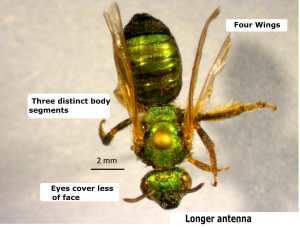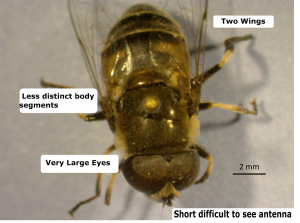For photos of local pollinators you may see, go to our “What pollinator is that?” page.
WINGS
Flies have one pair of wings while bees and wasps have two pairs. This may be difficult to observe when the insect is at rest. Flies usually hold their wings out at a 45° angle from their body. The wings are broad through the middle and may seem patterned. When bees and wasps rest, their wings usually lay flat against their bodies, sometimes crossing over at the tips. Their wings are narrow near the body and most broad at the tip. They may appear dark or iridescent but tend to not have a distinct visible pattern.
HEAD SHAPE, EYES, ANTENNAE
When observing the head of most flies, you will notice that they have short or barely visible antennae and that the eyes are very large, covering most of their face. Eye color can be black, red, or yellow.
Bees and wasps have long antennae that may appear jointed. Their eyes are oval-shaped, black and positioned on the sides of their head, leaving a “forehead” area. The head itself may be triangular.
BODY SHAPE
Flies rarely have a distinctive waist. They have round, short bodies with long wings. Bees and wasps have a distinct three-part body shape (head, thorax, abdomen) with a narrow waist. The body is often longer than the wings.
| BEE | FLY |
|---|---|
 |
 |